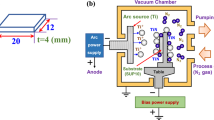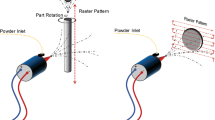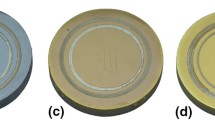Abstract
The residual stress in thermal barrier coatings (TBCs) fabricated from coating deposition plays a vital role in the coating design and processing parameters optimization. The main objective of the present work is to determine the interfacial residual stress in TBCs by means of miniature ring-core cutting and the digital image correlation (DIC) method. Both the ring-core cutting and the dot pattern used for DIC deformation measurement are implemented by the focused ion beam (FIB) milling on the cross-section of a coating. A finite element model (FEM) is developed to simulate the ring-core cutting process. From the FEM, the calibration coefficients are determined for general applications. The surface of the ring-core containing dot patterns is recorded before and after the FIB milling process. DIC technique is then performed to calculate the surface displacement caused by the release of residual stresses due to the cutting. Results demonstrate that the interfacial residual stress in TBCs is nearly in a uniaxial stress state and has a tendency to be compressive toward the interface. Finally, essential aspects of the technique are discussed.










Similar content being viewed by others
References
Evans AG, Mumm DR, Hutchinson JW, Meier GH, Pettit FS (2001) Mechanisms controlling the durability of thermal barrier coatings. Prog Mater Sci 46(5):505–553
Johnston RE (2009) The sensitivity of abradable coating residual stresses to varying material properties. J Therm Spray Technol 18(5–6):1004–1013. doi:10.1007/s11666-009-9378-2
Rabiei A, Evans AG (2000) Failure mechanisms associated with the thermally grown oxide in plasma-sprayed thermal barrier coatings. Acta Mater 48(15):3963–3976
Matejicek J, Sampath S, Dubsky J (1998) X-ray residual stress measurement in metallic and ceramic plasma sprayed coatings. J Therm Spray Technol 7(4):489–496
Matejicek J, Sampath S (2001) Intrinsic residual stresses in single splats produced by thermal spray processes. Acta Mater 49(11):1993–1999
Greving DJ, Rybicki EF, Shadley JR (1994) Through-thickness residual-stress evaluations for several industrial thermal spray coatings using a modified layer-removal method. J Therm Spray Technol 3(4):379–388
Wenzelburger M, López D, Gadow R (2006) Methods and application of residual stress analysis on thermally sprayed coatings and layer composites. Surf CoatTechnol 201(5):1995–2001
Liao H, Vaslin P, Yang Y, Coddet C (1997) Determination of residual stress distribution from in situ curvature measurements for thermally sprayed WC/Co coatings. J Therm Spray Technol 6(2):235–241
Clyne T, Gill S (1996) Residual stresses in thermal spray coatings and their effect on interfacial adhesion: a review of recent work. J Therm Spray Technol 5(4):401–418. doi:10.1007/bf02645271
Kesler O, Finot M, Suresh S, Sampath S (1997) Determination of processing-induced stresses and properties of layered and graded coatings: experimental method and results for plasma-sprayed Ni-Al2O3. Acta Mater 45(8):3123–3134
Matejicek J, Sampath S (2003) In situ measurement of residual stresses and elastic moduli in thermal sprayed coatings—Part 1: apparatus and analysis. Acta Mater 51(3):863–872. doi:10.1016/s1359-6454(02)00478-0
Zhu JG, Xie HM, Hu ZX, Chen PW, Zhang QM (2011) Residual stress in thermal spray coatings measured by curvature based on 3D digital image correlation technique. Surf CoatTechnol 206(6):1396–1402
Khan AN, Lu J, Liao H (2003) Effect of residual stresses on air plasma sprayed thermal barrier coatings. Surf CoatTechnol 168(2–3):291–299
Valente T, Bartuli C, Sebastiani M, Loreto A (2005) Implementation and development of the incremental hole drilling method for the measurement of residual stress in thermal spray coatings. J Therm Spray Technol 14(4):462–470. doi:10.1361/105996305X76432
Santana YY, La Barbera-Sosa JG, Staia MH, Lesage J, Puchi-Cabrera ES, Chicot D, Bemporad E (2006) Measurement of residual stress in thermal spray coatings by the incremental hole drilling method. Surf CoatTechnol 201(5):2092–2098. doi:10.1016/j.surfcoat.2006.04.056
Li KY, Ren W (2007) Application of miniature ring-core and interferometric strain/slope rosette to determine residual stress distribution with depth - part I: theories. J Appl Mech-Trans ASME 74(2):298–306. doi:10.1115/1.2198251
Wu Z, Lu JA, Han BT (1998) Study of residual stress distribution by a combined method of moire interferometry and incremental hole drilling, part I: theory. J Appl Mech-Trans ASME 65(4):837–843
Steinzig M, Ponslet E (2003) Residual stress measurement using the hole drilling method and laser speckle interferometry: Part I. Exp Techniques 27(3):43–46
Lord JD, Penn D, Whitehead P (2008) The application of digital image correlation for measuring residual stress by incremental hole drilling. Appl Mech Mater 13–14:65–73
Pan B, Qian KM, Xie HM, Asundi A (2009) Two-dimensional digital image correlation for in-plane displacement and strain measurement: a review. Meas Sci Tech 20(6):doi:10.1088/0957-0233/20/6/062001
Schajer G (2010) Relaxation methods for measuring residual stresses: techniques and opportunities. Exp Mech 50(8):1117–1127. doi:10.1007/s11340-010-9386-7
McCarthy J, Pei Z, Becker M, Atteridge D (2000) FIB micromachined submicron thickness cantilevers for the study of thin film properties. Thin Solid Films 358(1–2):146–151
Korsunsky AM, Sebastiani M, Bemporad E (2009) Focused ion beam ring drilling for residual stress evaluation. Mater Lett 63(22):1961–1963
Winiarski B, Langford RM, Tian JW, Yokoyama Y, Liaw PK, Withers PJ (2010) Mapping residual stress distributions at the micron scale in amorphous materials. Metall Mater Trans A 41(7):1743–1751. doi:10.1007/s11661-009-0127-4
McGinnis MJ, Pessiki S, Turker H (2005) Application of three-dimensional digital image correlation to the core-drilling method. Exp Mech 45(4):359–367. doi:10.1177/0014485105055435
Pan B, Xie HM, Hua T, Asundi A (2009) Measurement of coefficient of thermal expansion of films using digital image correlation method. Polymer Test 28(1):75–83. doi:10.1016/j.polymertesting.2008.11.004
Pan B, Xie HM, Guo ZQ, Hua T (2007) Full-field strain measurement using a two-dimensional Savitzky-Golay digital differentiator in digital image correlation. Opt Eng 46(3):doi:10.1117/1.2714926
Zhao X, Xiao P (2006) Residual stresses in thermal barrier coatings measured by photoluminescence piezospectroscopy and indentation technique. Surf CoatTechnol 201(3–4):1124–1131. doi:10.1016/j.surfcoat.2006.01.035
Zhu JG, Xie HM, Hu ZX, Chen PW, Zhang QM (2012) Cross-sectional residual stresses in thermal spray coatings measured by moire’ interferometry and nanoindentation technique. J Therm Spray Technol. doi:10.1007/s11666-012-9732-7
Montay G, Cherouat A, Lu J, Baradel N, Bianchi L (2002) Development of the high-precision incremental-step hole-drilling method for the study of residual stress in multi-layer materials: influence of temperature and substrate on ZrO2-Y2O3 8 wt.% coatings. Surf CoatTechnol 155(2-3):152–160
Scardi P, Leoni M, Bertini L, Bertamini L, Cernuschi F (1998) Strain gradients in plasma-sprayed zirconia thermal barrier coatings. Surf CoatTechnol 108–109:93–98
Wu Z, Lu JA, Han BT (1998) Study of residual stress distribution by a combined method of moire interferometry and incremental hole-drilling, part II: implementation. J Appl Mech-Trans ASME 65(4):844–850
Ren W, Li KY (2007) Application of miniature ring-core and interferometric strain/slope rosette to determine residual stress distribution with depth—part II: experiments. J Appl Mech-Trans ASME 74(2):307–314. doi:10.1115/1.2198252
Padture NP, Gell M, Jordan EH (2002) Thermal barrier coatings for gas-turbine engine applications. Science 296(5566):280–284
Schajer GS (2010) Advances in hole-drilling residual stress measurements. Exp Mech 50(2):159–168
Tsui YC, Clyne TW (1997) An analytical model for predicting residual stresses in progressively deposited coatings Part 1: planar geometry. Thin Solid Films 306(1):23–33
Hu YY, Huang WM (2004) Elastic and elastic-plastic analysis of multilayer thin films: closed-form solutions. J Appl Phys 96(8):4154–4160. doi:10.1063/1.1786339
Zhao X, Xiao P (2006) Residual stresses in thermal barrier coatings measured by photoluminescence piezospectroscopy and indentation technique. Surf CoatTechnol 201(3–4):1124–1131
Acknowledgements
The authors are grateful to the financial supported by the National Basic Research Program of China (“973” Project) (Grant No.2010CB631005, 2011CB606105), the National Natural Science Foundation of China (Grant Nos. 11172151, 90916010), Specialized Research Fund for the Doctoral Program of Higher Education (Grant No.20090002110048).
Author information
Authors and Affiliations
Corresponding author
Rights and permissions
About this article
Cite this article
Zhu, J.G., Xie, H.M., Li, Y.J. et al. Interfacial Residual Stress Analysis of Thermal Spray Coatings by Miniature Ring-Core Cutting Combined with DIC Method. Exp Mech 54, 127–136 (2014). https://doi.org/10.1007/s11340-012-9640-2
Received:
Accepted:
Published:
Issue Date:
DOI: https://doi.org/10.1007/s11340-012-9640-2




